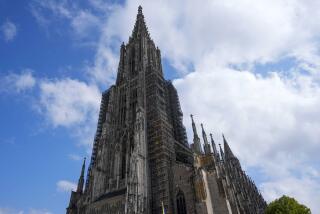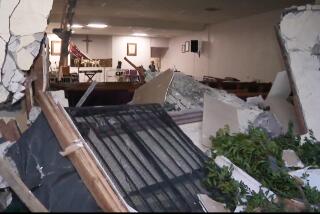Bell tolls for Germany’s churches
BRIEST, GERMANY — The tombstones in the graveyard are polished, but the village church, which counted only three Sunday regulars, was cracked and water-stained when it was sold for $10,000 to an aspiring filmmaker, who hung a poster of musician Lou Reed beyond the vestibule.
The altar was stripped. Icons and pews were carted off with the steeple bell. It’s hard to be precise about when things started going bad, but the church’s slide began after old pastor Giebler died during the German reunification and a once secure village frayed in the whirl of newfound freedom.
“When the political change happened, there was a huge atomization,” said the new owner, Juliane Beer, who as a child attended services here with her grandmother. “This village had a grocery, a post office, buses going by, but now it’s all gone, kaput. A church has been on this site since the 13th century. The only thing left are memories. Six years ago, a friend of my grandmother’s died in this church during Christmas Mass.”
Beer looked around. Her bed is in the choir loft and there’s an espresso machine where the hymnals used to be; the arched windows are clear but they rattle; cobwebs shimmy on fading whitewashed walls.
“Jesus is gone,” she said. “I’d like to turn it into a studio for artists.”
The village church is struggling for relevance in modern Europe. The continent is rooted in Christianity, but devotion is ebbing and church attendance has dropped steadily for years. In Germany and other nations, Protestant and Roman Catholic churches are selling properties or leasing them to other religious groups, especially in cities and villages where structures are left vacant as shrinking congregations merge.
Secular conversions
Churches have been reinvented as restaurants, coffee houses, clubs, apartments and music halls. Some have kept their frescoes and stained glass; others have been de-sanctified, yet their unmistakable facades and architecture leave an imprint of the holy on even the most capitalist of endeavors.
The churches of Europe have endured wars, plagues and much else, and although the current crisis is likely to pass, the image of the church is being significantly altered.
South of Briest, past asparagus fields and cattle, Christiane Beutel, the pastor of the Lutheran Church in the fishing village of Plaue, opened a church ledger from 1650. Written with ink and quill and held together by tape, the pages note the baptisms and deaths and the works of those whose bones have since turned to dust in the cemetery outside.
“There’s a trend in Germany and people are saying they don’t want to devote themselves to anything fixed, whether it be a church or a political party,” Beutel said. “They just want to live their lives and have fun. I think this comes from a collective disappointment that things didn’t turn out like people thought and illusions were shattered after communism fell.”
Tight church budgets mean Beutel’s duties are many and scattered. She and two other ministers serve five churches in the region. Her congregations in Plaue, southwest of Brandenburg city, and nearby Woltersdorf has shrunk to 600 from 800 in the last decade. This mirrored a pattern of decline in population and prosperity: Thousands of steel industry jobs were lost, Plaue closed its last school two years ago, and the town’s once strong band of 30 fishing families has dwindled to four.
A recent study by Dresdner Bank predicted that in the coming years, 50% of Germany’s churches may close or be turned into other uses. The nation’s Roman Catholic Church is expected to stop services in 700 of its 24,500 churches by 2015. Some of them, such as St. Laurentius in Berlin, are being rented to immigrant religious denominations. The Lutheran Church has sold a number of its churches to such groups, including a Serbian Orthodox community.
Declining population
Congregations slip away with each church funeral. Germany, a nation of 82 million people, has a low fertility rate that is unable to balance its rapidly aging population; government estimates suggest the working-age population will shrink by 21 million over the next two decades.
Other pressures on churches include secularization, villages emptying as people move to find work and a state religion tax collected from all church members, which keeps thousands from joining.
Meeting this year in Wittenberg, the home of the Reformation, an organization of mainline Protestant churches predicted that by 2030 membership would drop to 17 million from 25.6 million, and that annual income from the church tax, which helps support institutions, would be halved from about $5.4 billion to $2.7 billion.
“I think it’s time for more lay people to become involved and for church communities to learn they don’t need a priest to come every weekend,” said Beutel, whose Lutheran Church has cut its clergy in Germany by about one-third since 1990. “The church should live on in small families and groups. We know this is possible because of the Christian and Jewish diasporas over the centuries. People need to take more responsibility for their faith.”
Klaus Tanner, a professor of theology at Martin Luther University in Wittenberg, said many Christians were keeping their faith but were retracting from religious institutions. This dynamic is forcing Protestant churches to reorganize, trim budgets and contemplate diversifying programs with more missionary fervor.
“There’s tremendous pressure on the church,” he said. “There’s more competition, of course, and some churches will survive and some will not.”
With 100 members, only about 12 of whom show up regularly for Sunday service, the church in Woltersdorf was an uninspiring sight when Helmut Scheer, a retired steelworker and atheist raised in the former communist east, decided to help repair it.
The church, damaged in World War II and poorly renovated in the 1970s, was recently given a new tile roof and painted the color of a peach.
Scheer and a volunteer committee comprising atheists, agnostics and Christians believe the church is as much a part of the village’s architectural identity as it is a house of worship. “That unconscious connection” to the rural landscape, Scheer said, was more to do with aesthetics than with religion.
“The problem with the institutional church is the church tax,” Scheer said. “People want to get around that tax, but if the church has less income it has to offer less. In the end, this church will have fewer and fewer believers and will need more unbelievers to keep it going. It’s kind of ironic.”
Scheer opened the church door, winced at the drop ceiling and years of neglect, and mentioned that the Nazis melted the organ pipes to make cannons during the war. He estimated that $150,000, plus the sizable donation from an instant-pudding magnate, would be needed to fix up the inside.
The renovations will shut down the church for months, “but, you know,” Scheer said, “when it was closed during the earlier work we didn’t hear too many complaints about not having Sunday services.”
Question of survival
Over a squiggle of road and through the town of Plaue, the fishermen readied their long boats on the shore. Rope was coiled and net poles were sheared of bark and sunk into the silt.
As they worked near an old bridge, Pastor Beutel, who has an intimate understanding of history and scripture, closed the parish register and spoke of how the town lost out on the china business years ago and of the rumors that the Duchess Lily, a church benefactor connected to Kaiser Wilhelm, may have been poisoned in 1911.
“When I came here 10 years ago, my task was to organize the worship and take care of some old ladies,” she said.
“But I thought step by step we need to build some new initiatives. I started a brass band and a children’s choir. I’m doing other things too, so much outside of my theological training, but that’s what it will take if the church is to survive.”
She walked through the vestibule and toward the altar, past small statues with chipped feet and lost arms, past the pews and up wooden steps to a mural of the Passion of the Christ, which, painted centuries ago in pastels, rose to the ceiling in images that were at once vibrant and half obscured. She shifted her eyes, pointing to souls rising to heaven, to others tumbling into hell.
She went down the steps and outside to the graveyard. Beyond the trees and mausoleums, the river flowed in the distance, the same river that in a few months Beutel, in a ceremony Plaue pastors have performed for centuries, would venture onto in a boat and ask the patron saint of fishermen to bless the waters and those who work upon them.
More to Read
Sign up for Essential California
The most important California stories and recommendations in your inbox every morning.
You may occasionally receive promotional content from the Los Angeles Times.











